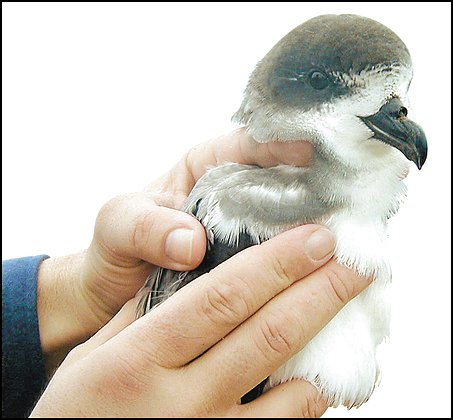| 새로운 사진 | 신문속의 동물소식 | 신기한 동물이야기 | 동물의 소리 | 동물동화상 | 사진 올리기 | 사진 저작권 | English |
|---|
| 재미있는 동물사진 | 괴수/괴어/엽기 동물사진 | 동물이름사전 | 동물목록 | 바깥고리 | 창고입구 | 똑똑누리집 |
|---|
| 이미지 정보 | Original File Name: Bermuda Petrel (Pterodroma cahow).jpg Resolution: 453x420 File Size: 64022 Bytes Date: 2003:11:07 14:53:00 Upload Time: 2007:12:13 14:30:04 | |
| 올린이 | 이름 (메일주소): Unknown | |
| 사진 제목 | Bermuda Petrel (Pterodroma cahow) - Wiki | |
 |
| Email : 카드 | 올린이 | 운영자 사진삭제 정보수정 Admin |
| 설명 | Bermuda Petrel (Pterodroma cahow) - Wiki
Bermuda Petrel
The Bermuda Petrel Pterodroma cahow is a gadfly petrel. Commonly known in Bermuda as the Cahow, a name derived from its eerie cries, this nocturnal ground-nesting seabird is the national bird of Bermuda, and a symbol of hope for nature conservation. It was thought extinct for 330 years. Its dramatic rediscovery as a "Lazarus species", that is, a species found to be alive after being considered extinct for centuries, has inspired documentary filmmakers. Initially superabundant throughout the archipelago, the Cahow is a slow breeder, but excellent flier, and spends its adult life on the open seas. At five years old it returns to its former nesting place and begins breeding, laying only one egg per season. Cahows mate for life. The Cahows' eerie nocturnal cries stopped the early Spanish seafarers settling the Islands out of superstition, as they thought the Isles were inhabited by Devils. Instead they put ashore hogs as a living foodstore for passing ships, and so began the onslaught on the Cahow's existence. Following Bermuda's colonisation by the British, introduced species like rats, cats and dogs, and mass killings of the birds by early colonists decimated numbers. Despite being protected by one of the world's earliest conservation decrees, the Governor's proclamation "against the spoyle and havocke of the Cohowes," the birds were thought to have been driven to extinction since the 1620s. In 1951, 18 surviving nesting pairs were found on rocky islets in Castle Harbour, and a program was set up by David B. Wingate to build concrete burrows and wooden bafflers for the nesting tunnels in order to keep out the slightly larger, competing 'Bermuda longtail', and to restore the nearby Nonsuch Island to be a future viable base for the species. Enjoying legal protection, the species has started to make a good recovery, The main threat for the future is lack of suitable breeding habitat. Hurricane Fabian destroyed many nesting burrows in 2003, and recently the larger and ecologically-restored Nonsuch Island is being repopulated with chicks, their translocation timed so they will imprint on these surroundings. This work is being undertaken by the present Bermuda Conservation Officer Jeremy Madeiros assisted by the Australian petrel specialist Nick Carlile. Nonetheless, the global population of this bird in 2005 was only about 250 individuals. http://en.wikipedia.org/wiki/Bermuda_Petrel
| |||
| 저작권 정보 | 사진의 저작권은 원저작자에게 있습니다. 동물그림창고는 동물관련 사진을 전시할 수 있는 공간만을 제공합니다.사진을 사용하고자 할 경우에는 저작권자와 협의하시기 바랍니다. |
|
|
|
| |||||||
| CopyLeft © since 1995, 동물그림창고. All rights may be reserved. | ||||||||
Stats